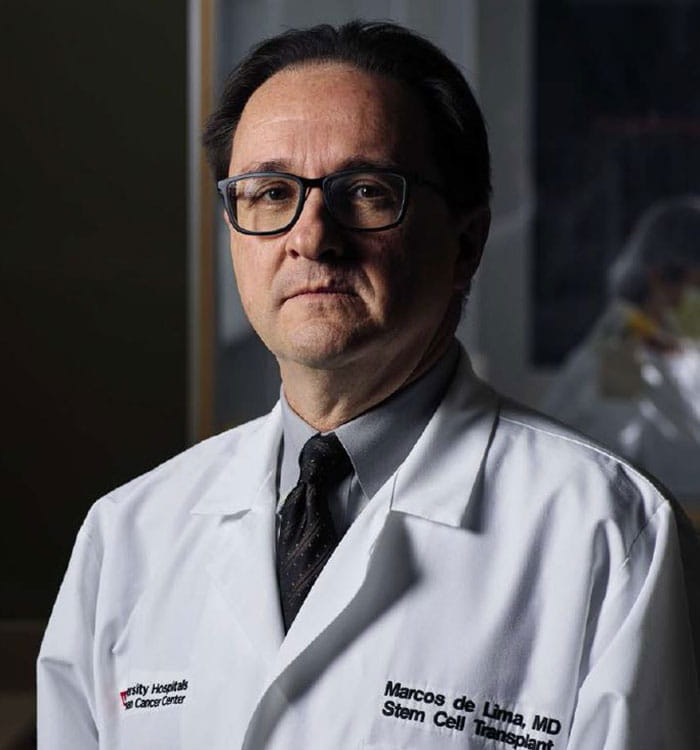Improving the Odds
January 01, 2016
Trial-focused SCT Program at UH Seidman Cancer Center looks to boost cure rates for hematologic malignancies
Innovations in Cancer - Winter 2016 Download PDF
 Marcos de Lima, MD
Marcos de Lima, MDAfter stem cell transplant (SCT), cure rates for hematologic malignancies among adults hover between 30 and 50 percent. For Marcos de Lima, MD, these disappointing numbers represent an invitation to innovate.
“For the vast majority of these diseases, there simply are no standards of care,” says Dr. de Lima, Director of the Hematologic Malignancies and Stem Cell Transplant Program at University Hospitals Seidman Cancer Center, and Professor of Medicine, Case Western Reserve University School of Medicine. “There are silver standards, but not gold standards. Given this situation, our commitment is that the best treatment is often a clinical trial.”
Since arriving at UH Seidman Cancer Center three years ago from M.D. Anderson Cancer Center in Houston, Dr. de Lima and his team have tripled the number of investigator-initiated, locally developed therapeutic clinical trials available to patients with hematologic malignancies. These trials focus on three broad goals of the program: finding donors for every patient who needs a donor cell transplant, reducing the toxicity of the SCT process and reducing relapse rates.
“Unfortunately, relapse after transplant is still a huge problem,” Dr. de Lima says. “It‘s one of the great paradoxes of our field. Over the last 20 years, the toxicity of transplants has gone down. The tradeoff is that we see people whose disease comes back more readily.”
To address the challenge of a lack of matched donor cells, Dr. de Lima is embarking on a pilot project combining donor cord blood cells with mesenchymal stromal cells (MSCs) harvested from a volunteer unrelated to the donor or recipient. To avoid the problem of cells that get ‘lost’ in the bloodstream, he and his team are injecting these cells directly into patients’ bone marrow. The MSCs are injected into the bone marrow immediately before the cord blood.
“We’ve seen that if we combine human cord blood cells with MSCs from an unrelated human and inject the combined cells into a recipient mouse’s leg bone, we see better engraftment with more donor cells remaining in the marrow,” Dr. de Lima says.
A trial with 10 to 12 patients, using this approach, is now under way at UH Seidman Cancer Center, with the first patient receiving treatment in late 2015.
“Ultimately, if it does succeed, it could challenge the standard of care, which is currently to do a double cord blood transplant,” Dr. de Lima says. “What we’re proposing is a complete shift.”
Another trial under way within the program is tackling the tradeoff between toxicity and relapse, which can be a special problem for older patients with hematologic malignancies. Because of age and reduced overall health, these patients often receive what Dr. de Lima describes as “reduced intensity transplants” or “mini transplants,” which may leave them vulnerable to relapse.
“We’re investigating whether we can add radiation to the standard transplant for older adults,” he says.
The twist is that the radiation is delivered only to the skeleton, using sophisticated body mapping and total marrow irradiation (TMI) technology, sparing the lungs and other tissues.
“You avoid more toxicity to the lungs, for example, so theoretically, you’re taking away some of the side effects,” Dr. de Lima says.
Making SCT as safe as possible for patients is also a key priority, Dr. de Lima says. This manifests itself in both research and clinical care. On the research side, he and his team are investing in laboratory bioreactors that will allow for the cultivation and selection of subsets of cells to attack cytomegalovirus (CMV) in SCT recipients.
“CMV is a pest after transplant,” Dr. de Lima says. “Sometimes we have a hard time treating it with drugs. The idea is that we’ll be able to separate lymphocytes from a donor that only recognize this particular virus, so you can give the cells without risk of side effects. They’ll just attack the virus.”
Clinically, the team is committed to standardizing procedures where possible and making nurses experts in certain pieces of what can be an involved SCT process.
“There is a lot of engagement by the nursing staff, which is vital to our success,” Dr. de Lima says. “When they become knowledgeable, they become partners and another check on the process. You want as many checks as possible in this huge process that we have.”
For more information about the SCT Program at UH Seidman Cancer Center, email Marcos.DeLima@UHhospitals.org.
Tags:


